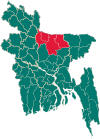|
Nandail Upazila
Nandail (Bengali: নান্দাইল) is an upazila of Mymensingh District[3] in the division of Mymensingh, Bangladesh, and is located roughly 46 kilometers from Mymensingh City. HistoryDuring the rule of Alauddin Husain Shah, Muazzamabad (currently, Muazzampur) was the administrative headquarters of East Bengal. The British established Neel Kuthi (Indigo center) in the 18th century at the Razbari Bazaar of Nandail, and the indigo revolt started in the area. In 1971 Nandail suffered many losses. On 21 April, the Pakistan army killed 18 people and burned a few hundred houses in the Rajgati, Shuvokhila, and Kaliganj areas. On 17 November, a total of 27 freedom fighters including Illias Uddin Bhuiyan, Shamsul Haque, Zillul Baki, Thana Awami, and Shahnewaz Bhuiyan were killed in a battle with Pakistan. This day is now observed as the Nandail Shaheed Day. GeographyNandail is located at 24°34′00″N 90°41′00″E / 24.5667°N 90.6833°E. It has 87,523 households and a total area of 326.37 km2. It is bounded by Ishwarganj Upazila to the north, Hossainpur and Kishoreganj Sadar Upazilas to the south, Kendua and Tarail Upazilas to the east, Trishal and Gaffargaon Upazilas to the west. The old Brahmaputra and Narsunda rivers are almost gone; and noted depressions are Talar Kur, Zilla Beel, Hamai Beel, Aralia Beel, Balda Beel, Bapail beel and Tongi Beel. DemographicsAccording to the 2011 Census of Bangladesh, Nandail Upazila had 87,523 households and a population of 402,727. 116,556 (28.94%) were under 10 years of age. Nandail has a literacy rate (age 7 and over) of 40.38%, compared to the national average of 51.8%, and a sex ratio of 1032 females per 1000 males. 43,413 (10.78%) people lived in urban areas.[5][6] As of the 1991 Bangladesh census, Nandail had a population of 328,847. Males constituted 50.82% of the population, and females 49.18%. The upazila had a population of 155,930 aged 18 or over. Nandail had an average literacy rate of 22.3% (7+ years), compared to a national average of 32.4%.[7] EconomyNandail upazila has an agrarian-based economy. The dominant occupations (by percentage) are:
The land is divided into cultivable and fallow land. Jute, paddy, wheat, potato, gourd, and aubergine are the main crops. There are few flour and textile mills, and other industries include cottage industries, weaving, bamboo work, blacksmiths, goldsmiths, potteries, tailoring, welding, and wood work. AdministrationNandail upazila was established on 15 December 1982. Nandail Upazila is divided into Nandail Municipality and 12 union parishads: Achargaon, Batagoir, Chandipasha, Gangail, Jahangirpur, Kharua, Muajjempur, Mushulli, Nandail, Rajgati, Sherpur, and Singroil. The union parishads are subdivided into 163 mauzas and 265 villages.[8] Nandail Municipality is subdivided into 9 wards and 20 mahallas.[8] The area of the Pouroshova is 13.05 km2. It has a population of 28,045 – male 50.34%, female 49.66%. The population density is 2149 per km2. The literacy rate among the town is 37.5%. EducationThere are seven colleges in the upazila. They include Khurram Khan Chowdhury Degree College, Samurta Jhan Mohila College, and Shaheed Smriti Adarsha College, founded in 1972.[9] According to Banglapedia, Chandipasha Government High School, founded in 1915, and Nandail Road High School are notable secondary schools.[3] The madrasa education system includes seven fazil madrasas.[10] Notable people
See alsoReferences
|
||||||||||||||||||||||||||||||||||||
Portal di Ensiklopedia Dunia



